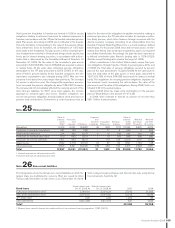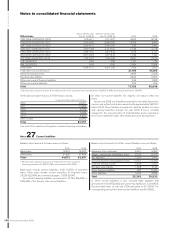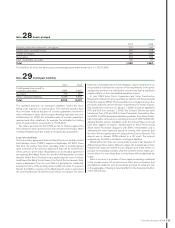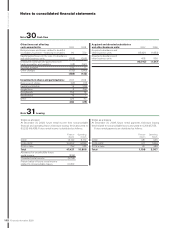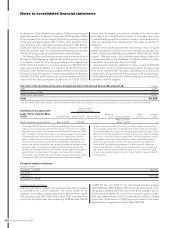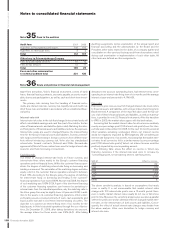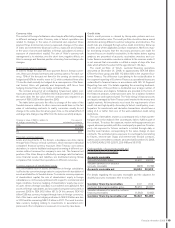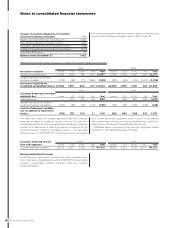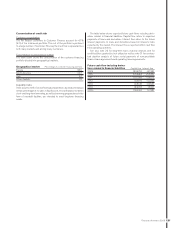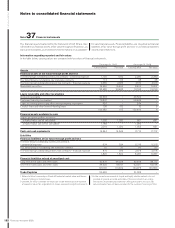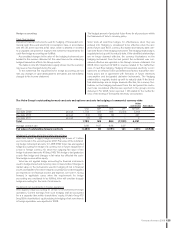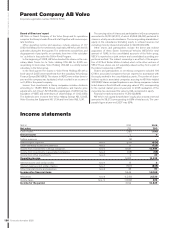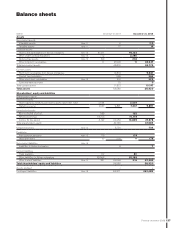Volvo 2008 Annual Report Download - page 122
Download and view the complete annual report
Please find page 122 of the 2008 Volvo annual report below. You can navigate through the pages in the report by either clicking on the pages listed below, or by using the keyword search tool below to find specific information within the annual report.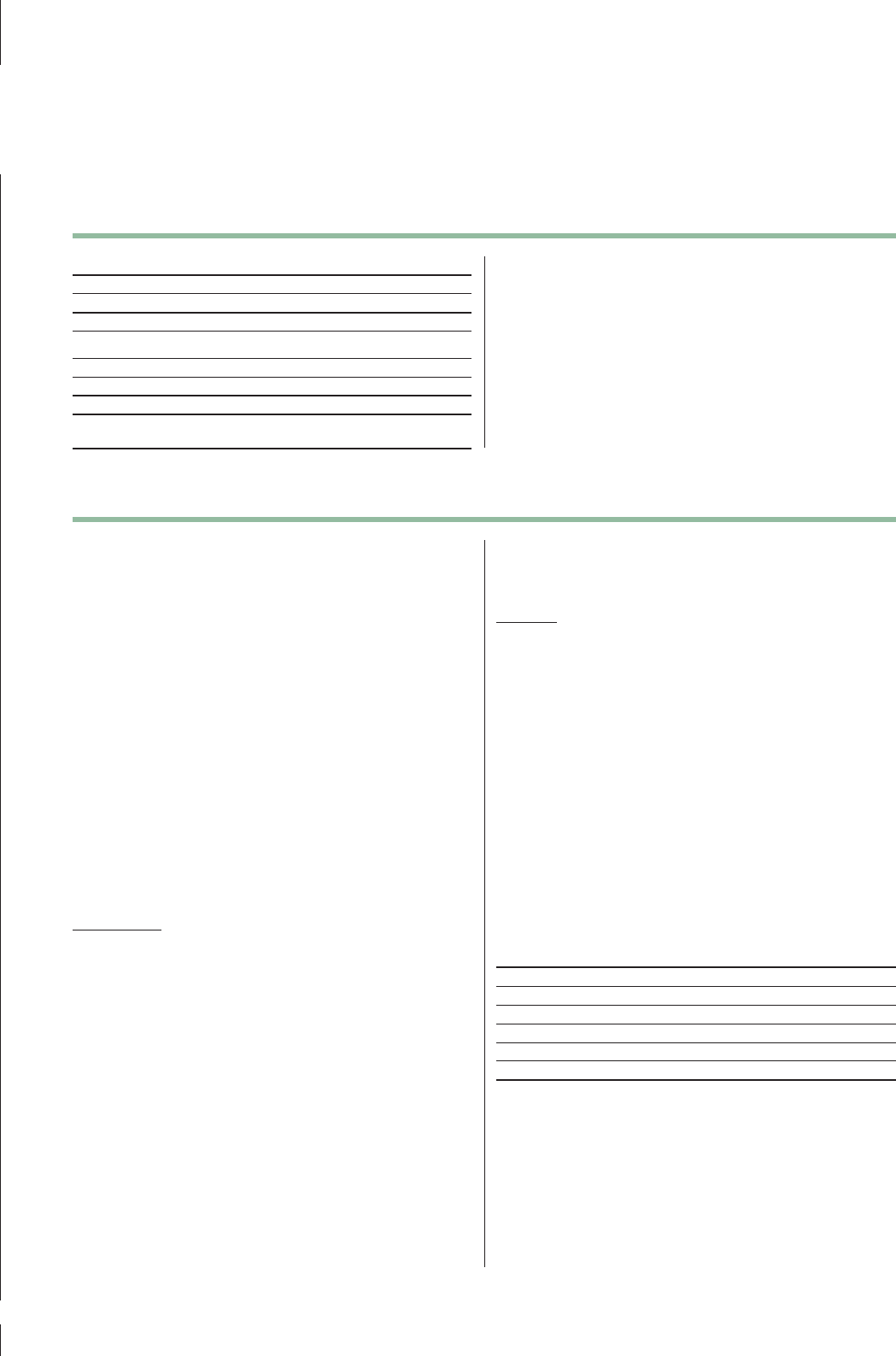
118
THE VOLVO GROUP
Financial information 2008
Note 35 Fees to the auditors
Audit fees 2007 2008
Audit fees to PricewaterhouseCoopers 109 105
Audit fees to other audit fi rms 32
Total 112 107
Other fees to PricewaterhouseCoopers
Fees for audit related services 97 12
Fees for tax services 12 17
Total 109 29
Fees and other remuneration
to external auditors total 221 136
Auditing assignments involve examination of the annual report and
fi nancial accounting and the administration by the Board and the
President, other tasks related to the duties of a company auditor and
consultation or other services that may result from observations noted
during such examination or implementation of such other tasks. All
other tasks are defi ned as other assignments.
Note 36 Goals and policies in fi nancial risk management
Apart from derivatives, Volvo’s fi nancial instruments consist of bank
loans, fi nancial leasing contracts, accounts payable, accounts receiv-
able, shares and participations, as well as cash and short-term invest-
ments.
The primary risks deriving from the handling of fi nancial instru-
ments are interest-rate risk, currency risk, liquidity risk and credit risk.
All of these risks are handled in accordance with an established fi nan-
cial policy.
Interest-rate risk
Interest-rate risk refers to the risk that changed interest-rate levels will
affect consolidated earnings and cash fl ow (cash-fl ow risks) or the fair
value of fi nancial assets and liabilities (price risks). Matching the inter-
est-fi xing terms of fi nancial assets and liabilities reduces the ex posure.
Interest-rate swaps are used to change/infl uence the interest-fi xing
term for the Group’s fi nancial assets and liabilities. Currency interest-
rate swaps permit borrowing in foreign currencies from different mar-
kets without introducing currency risk. Volvo also has standardized
interest-rate forward contracts (futures) and FRAs (forward-rate
agreements). Most of these contracts are used to hedge interest-rate
levels for short-term borrowing or investment.
Cash-fl ow risks
The effect of changed interest-rate levels on future currency and
interest-rate fl ows refers mainly to the Group’s customer fi nancing
operations and net fi nancial items. Within the customer fi nance oper-
ations the degree of matching interest-rate fi xing on borrowing and
lending is measured. The calculation of the matching degree excludes
equity, which in the customer fi nance operations amount to between
8 and 10%. According to the Group’s policy, the degree of matching
for interest-rate fi xing on borrowing and lending in the customer-
fi nancing operations must exceed 80%. At year-end 2008, the degree
of such matching was 100% (100). A part of the short-term fi nancing
of the customer fi nancing operations can however be pertaining to
internal loans from the industrial operations, why the matching ratio in
the Volvo group then may be slightly lower. At year-end 2008, in add-
ition to the assets in its customer-fi nancing operations, Volvo’s inter-
est-bearing assets consisted primarily of cash, cash equivalents and
liquid assets invested in short-term interest-bearing securities. The
objective is to achieve an interest-fi xing term of six months for the
liquid assets in Volvo’s industrial operations through the use of deriva-
tives. On December 31, 2008, after taking derivatives into account,
the average interest on these assets was 2.9% (4.4). After taking
derivatives into account, outstanding loans had interest terms corre-
sponding to an interest-rate fi xing term of six months and the average
interest at year-end amounted to 4.1% (4.5).
Price risks
Exposure to price risks as result of changed interest-rate levels refers
to fi nancial assets and liabilities with a longer interest-rate fi xing term
(fi xed interest). A comparison of the reported values and the fair val-
ues of all of Volvo’s fi nancial assets and liabilities, as well as its deriva-
tives, is provided in note 37, Financial instruments. After the transition
to IFRS in 2005, the market values agree with the book values.
Assuming that the market interest rates for all currencies suddenly
rose by one percentage point (100 interest-rate points) over the inter-
est-rate level on December 31, 2008, for the next 12-month period, all
other variables remaining unchanged, Volvo’s net interest income
would be negatively impacted by 88 (negatively 25) considering an
interest rate fi xing term of six months. Assuming that the market inter-
est rates for all currencies fell in a similar manner by one percentage
point (100 interest-rate points), Volvo’s net interest income would be
positively impacted by a corresponding amount.
The following table shows the effect on income in Volvo’s key
fi nancing currencies if the interest-rate level were to increase by
1 percentage point, not considering interest rate fi xing terms.
SEK M Effect on income
SEK 62
USD (17)
EUR (130)
CAD (12)
JPY (125)
KRW 8
The above sensitivity analysis is based on assumptions that rarely
occur in reality. It is not unreasonable that market interest rates
change with 100 interest-rate points over a 12-month period. How-
ever, in reality, market interest rates usually do not rise or fall at one
point in time. Moreover, the sensitivity analysis also assumes a parallel
shift in the yield curve and an identical effect of changed market inter-
est rates on the interest-rates of both assets and liabilities. Conse-
quently, the effect of actual interest-rate changes may deviate from
the above analysis. Volvo uses derivatives to hedge currency and
interest rate risks.
Notes to consolidated fi nancial statements



